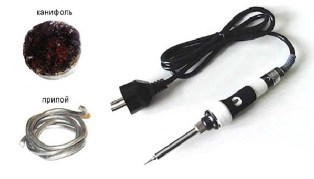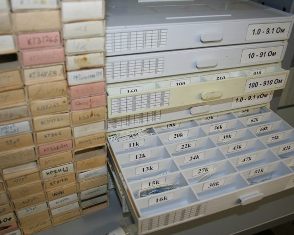Categories: Featured Articles » Practical Electronics
Number of views: 42390
Comments on the article: 3
Radio amateur workshop - tools, materials and measuring instruments for work
 To begin with, who are hams. Amateur radio, as a mass phenomenon, arose along with the appearance in life of the first radio receivers in the twenties of the last century: many were interested in what was inside and how it worked. In fact, a radio amateur is an engineer without a diploma.
To begin with, who are hams. Amateur radio, as a mass phenomenon, arose along with the appearance in life of the first radio receivers in the twenties of the last century: many were interested in what was inside and how it worked. In fact, a radio amateur is an engineer without a diploma.
In the first part I told on the development of the element base of radio electronics, and along the way about the development of computers. This article is a story about the construction of an amateur radio workshop, about the tools, materials and measuring instruments that are used by amateur radio enthusiasts in their practical activities. The article is intended mainly for beginner hams. I would be glad if this article is useful to readers of the site!
Amateur workshop room
If you decide to engage in amateur radio, then the legitimate question arises, but where do they deal with, where to place the smallest workshop? There are many answers to this question. If you have a private house, then several free square meters can be found anywhere from the basement to the attic: there is always a corner for classes.
If you live in an apartment building, then you will have to displease the household to conquer a corner in one of the rooms. If the apartment has a loggia, then in the warm season it is quite possible to open a small workshop on it. In some old apartments, which are now called "slums", there are small pantries with dimensions not exceeding 1.5 * 2.5 m. If there is such a room, then you are very lucky.
There are even recommendations in the literature to use just a piece of linoleum of suitable sizes, which can be laid on any table even polished, so as not to scratch it, fill it with flux and spray it with molten solder. Such a “workshop” has even some advantages over a large separate room: after work, you will have to clean everything and store it somewhere. In such a situation, it is unlikely that the entire room will be littered with unfinished projects. And this happens quite often.
Ham radio wiring tool
At first, it will be enough to acquire side cutters, pliers, and medical tweezers will not be superfluous. You will need a radio-cutting knife, a scalpel, or a Chinese-made breadboard knife.
There should be several screwdrivers, it’s better to buy a set right away, maybe not very big and expensive. After all, it is quite common that the device that got into repair cannot be disassembled due to several screws with non-standard slots. In the future, as needed, a variety of tools are bought.
Soldering iron
Just soldering irons
One of the main tools of the ham, of course, is soldering iron. It is better if there are several soldering irons for different jobs. Most often, these are ordinary domestic household soldering irons of the EPSN brand with a power of 25 and 40 W with a copper sting. To protect against burning, it can be coated with a thin layer of a composition prepared on the basis of silicate glue (water glass), in which zinc or magnesium oxide powder is diluted. You can use this sting only after the coating has completely dried at room temperature. If this is not expected, then when you turn on the soldering iron, the coating will foam and crumble.
EPSN soldering iron heaters last a long time, they can survive more than one sting. Therefore, after each soldering, the tip should be removed and cleaned of scale, then replacing the tip will not cause any problems.Despite the fact that the most experienced, or as they say “cool” specialists in the field of soldering, say that on occasion you can solder anything with an ax, it’s better to use a good soldering iron.
Modern soldering irons
With a modern element base, it is recommended to use low-voltage soldering irons with temperature regulators. The tips of such soldering irons, as a rule, have coatings that prevent burnout. There are also multilayer stings. In no case can they be sharpened with a file or sandpaper: if the coating is broken, then the quick burning of the sting simply can not be avoided. Such non-burning stings are sold separately and have quite a variety of forms of the working end, which always allows you to buy exactly what you need.
If the business of amateur radio does not stall at the very beginning, then with the accumulation of experience and the complexity of the work, you can get real branded soldering irons. As in everything else, this issue should be guided by the price / quality ratio. Do not immediately buy a Weller soldering iron. His sting is almost forever, the temperature adjustment parameters are impeccable, according to experts, who at least once soldered with this soldering iron will not want to go to others. The price of Weller soldering irons reaches 10 000 rubles! So try to sharpen the sting with a file!
But fortunately, good soldering irons are produced by many companies. These are Japanese HAKKO and Goot, German ERSA, American PACE, Weller, OKI, as well as the Chinese brand ATTEN and many others. Among this variety you can always find what was needed in any situation.
Fig. 1. Soldering iron, solder and rosin
Soldering materials
Together with a soldering iron should be purchased solder and flux. Rosin is used as a flux, preferably light or ready-made liquid fluxes based on it. Liquid flux is easy to prepare at home. To do this, simply crushed rosin is simply dissolved in alcohol. You can also buy ready-made liquid flux, for example LTI-120, but most often you have to add rosin to it.
Solder is best suited to domestic POS-61 in the form of a wire with a diameter of 0.8 - 1.0 mm. Often, such solders also contain rosin. Some imported solders may contain other fluxes inside, for example CIF-10, smell something like neutral solder fat.
By the way, a few words about this fat: if you had to solder old antenna connectors with a dull gray coating, then it is very difficult to solder it with rosin. This is not forgotten. But with neutral fat it’s very simple and fast, which is called one-touch !!! The main thing here is not to confuse - instead of neutral fat, do not use acid.
As in the case of soldering irons, sooner or later it will be necessary to acquire other solders and other fluxes. It all depends on the size of the electronic components and the design of their enclosures.
How to store radio components
Of course, you can dump everything in a big pile, and look for the necessary part from it. Such an activity will take a lot of time and get tired very soon, and in the end, it will destroy all enthusiasm, and amateur radio will end there. Although, most likely, it will just make you look for other storage methods.
Modern details are small, but there are not so many of them at a home craftsman. For these purposes, special boxes with cells are sold in stores and on radio markets. It is better to put the details in the cell in a small plastic bag. If you cannot buy such a box, then you can simply glue several matchboxes together. Also, boxes with sections for threads and needles sold in fabric stores are good.
Fig. 2. Cassette holder for storing radio components
Measuring instruments in the workshop of a radio amateur
Avometers and multimeters
It is completely impossible to engage in the design or repair of electronic devices without measuring instruments, because electricity has no taste, no color, no smell (nothing is burning yet).If you recall Ohm's law, then you have to measure current, voltage and resistance in electrical circuits. But it is not necessary to have three separate devices: an ammeter, a voltmeter and an ohmmeter. It is enough to purchase a combination device AmperVoltOmmeter or just an avometer. Another such universal device is often called a tester.
Such names are most often applied to good old switches. A good switch tester is one with an input impedance of at least 20 kΩ / V in the DC voltage measurement mode. Such a device will not “plant” the measurement result even in high-resistance sections of the electric circuit, for example, on the bases of transistors.
Currently more popular digital multimeters. Their measurement result is shown in the form of numbers, which does not compel the mind to recount the readings, as in the case of using a pointer device. The input impedance of multimeters is much higher than that of arrow meters and is at all limits 1MOhm. Besides current measurement, voltages and resistances, virtually all multimeter models can measure transistor gain. Of the additional functions can be called measuring the capacitance of capacitors, frequency, temperature. Some models have a rectangular pulse generator of sound frequency.
See also: How to work with a multimeter
Oscilloscope
The oscilloscope is the most versatile measuring device, and therefore the most expensive. Unlike a conventional voltmeter, it allows, in addition to the magnitude of the signal, its level, to examine in detail the form, time characteristics, or simply check whether this signal is present or not. The device of the oscilloscope and measurement methods with its help are complex and diverse, a separate article should be written about this.
Currently, more and more widespread digital oscilloscopes, made either as a standalone device, or as a set-top box to a computer. Both of them are quite expensive, so for amateur purposes you can recommend an old electron-beam oscilloscope, which can now be bought on any radio market at a fairly affordable price. In some cases, a virtual oscilloscope can help out - a computer program. This will be discussed in the next article.
Like any serious business, amateur radio requires a lot of practical skills, theoretical knowledge of curiosity and love, because it is not for nothing that it is called amateur radio! Practical exercises are best started with designs that do not require adjustment, work immediately. As a rule, these are flashers and tweeters based on classical electronic circuits, primarily multivibrator. The revived design inspires confidence in one's strengths and forces one to conquer new heights!
Boris Aladyshkin
Continuation of the article: Computer technology in the service of a radio amateur
See also at bgv.electricianexp.com
:


